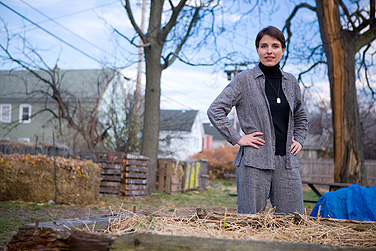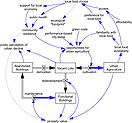News
Modeling Buffalo’s urban food movement

Geographer Sara Metcalf has developed a conceptual model in the form of a “causal map” that shows how different elements within Buffalo’s urban food movement relate to one another. Photo: DOUGLAS LEVERE
-
 Print
Print -
 Comments
(1)
Comments
(1)
-

This causal map depicts the impacts of land-use change and local food choice. Image: APPLIED GEOGRAPHY
As Rust Belt cities transform vacant lots into green space for growing vegetables, UB researchers are using modeling to help assess the city of Buffalo’s capacity for sustainable agriculture.
Specifically, geographer Sara Metcalf has developed a conceptual model in the form of a “causal map” that shows, visually, how different elements within Buffalo’s urban food movement relate to one another.
The map shows feedback involving land use, showing how vacant lots represent an opportunity for urban agriculture, how urban agriculture can increase familiarity with local food and how that familiarity can result in greater support for the cultivation of vacant lots into urban farms.
While these relationships express common sense, the process of mapping them serves to inform dialogue among farmers, policymakers and community advocates. Imagining a single linkage within the food system is simple, but visualizing a complex system is not.
An article describing the research conducted by Metcalf and co-author Michael Widener, a geography PhD candidate, is scheduled to appear in a forthcoming edition of the peer-reviewed journal Applied Geography. Click here to read the paper.
Besides the causal map, the article also includes a geographic analysis of local access to grocery stores, conducted by Widener, that reveals urban areas with a grocery gap.
The causal map detailed in the paper reflects the input of the Massachusetts Avenue Project (MAP), a Buffalo-based sustainable agriculture organization, and scholars and practitioners attending conferences where Metcalf and Widener presented preliminary research.
The diverse elements of the local food system that the geographers’ map addresses include affordability, public health, community resilience, support for the local economy, public perception of urban decline and the potential adoption of a “green code” that could make it easier to sustain urban farms.
As more residents choose local food from sustainable sources, familiarity and community support for urban agriculture can improve, says Metcalf, an assistant professor of geography. Individual choices are constrained by affordability and access, but aggregate to impact community resilience through environmental, social and economic sustainability.
“The causal map is useful for visualizing feedback,” Metcalf says. “Relationships are inherently invisible, and by making them visible, stakeholders can debate them. A good model can inform policy.”
Metcalf’s research was supported by a research fellowship from the UB 2020 Civic Engagement and Public Policy strategic strength initiative to learn from MAP and other local food actors about the prospects for sustainable agriculture in Buffalo.
Metcalf emphasizes the causal map’s utility as a framework for future research using systems modeling to explore urban food production. Metcalf and Widener’s future research involves multiple models for examining different facets of local food systems—production, distribution, consumption, policy and planning.
Widener’s PhD dissertation research, under Metcalf’s direction, involves modeling dynamics of the urban food environment, examining issues of access and food preference in greater detail. Metcalf continues to interact with MAP, Buffalo Growing and other “locavores” to develop a social model of awareness about and commitment to the local food movement.

Reader Comments
Kyle F. Reinson says:
This is the sort of research that has implications beyond the Rust Belt. The burst of the housing bubble in many markets across America could lead to urban and suburban food movements and if community standards are recast away from the lawn of grass in the front yard this paper could be a cornerstone for a burgeoning body of knowledge on reinventing American cities by getting people back into the process of agriculture. Compelling work. I thank the authors.
Posted by Kyle F. Reinson, Assistant Professor, St. John Fisher College, 06/03/11